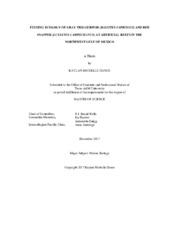| dc.description.abstract | This study examined the feeding ecology of two reef fishes using gut content and stable isotope analyses to assess the role of artificial reefs as foraging habitat in the Northwest Gulf of Mexico (GoM). Reefs were divided into three regions (north, central, south) across a north to south gradient of increasing salinity due to decreasing rates of freshwater inflow. Crabs were the dominant prey for both Gray Triggerfish Balistes capriscus (24 %), and Red Snapper Lutjanus campechanus (27 %). Gray Triggerfish consumed more xanthid crabs, pelagic gastropods, and reef associated prey, while non-reef prey (portunid crabs, fish, stomatopods) were prominent in Red Snapper. Natural stable isotopes of carbon (ẟ¹³C), nitrogen (ẟ¹⁵N), and sulfur (ẟ³⁴S) were measured for primary producers and muscle tissue of both species, and examined by age, species, and region. Muscle tissue ẟ¹³C and ẟ¹⁵N values increased with ontogeny for each species. Gray Triggerfish had lower ẟ¹³C and ẟ¹⁵N values across all age classes and a larger Standard Ellipse Area (SEAc) relative to Red Snapper. Contribution estimates of particulate organic matter (POM, 32 – 60 %) and benthic microalgae (BMA, 40 – 68 %) were comparable for each species, with greater BMA contributions within most age classes (x difference = 21.8 %). Red Snapper gut contents and stable isotope values of ẟ¹³C, ẟ¹⁵N, and ẟ³⁴S differed across regions. Red Snapper from the south region showed differing trends with ontogeny (ẟ¹⁵N decreased with fish size), and a larger SEAc compared to the north and central regions. This study demonstrates differences in feeding and resource partitioning between Gray Triggerfish and Red Snapper across multiple age classes, as well as the importance of benthic (BMA) primary production to consumers at artificial reefs in the GoM. | en |


